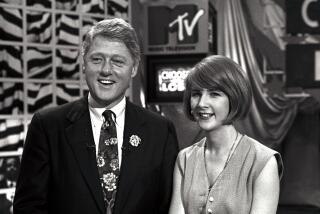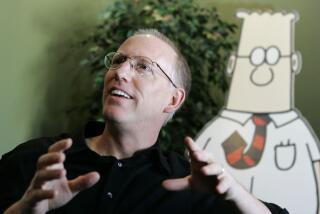Life Behind the Pen : HERBLOCK: A Cartoonist’s Life, <i> By Herbert Block (Macmillan Publishing, A Lisa Drew Book: $24; 372 pp., illustrated)</i>
- Share via
Writers have the first and middle, as well as the last, word, so let me say at the outset that I think the most difficult job in newspapering is editorial cartooning. It requires the ability to create, on a daily deadline, a drawing and caption that, at best, absolutely defines its subject.
We’ve been well served by many great American editorial cartoonists: to name just a few, there was Thomas Nast (who worked for a weekly), Dan Fitzpatrick, Bill Mauldin and The Times’ own Paul Conrad.
None of them have done it better, certainly none longer, than Herbert Block, the editorial cartoonist who signs himself Herblock. He’s worked since 1946 for the Washington Post, but by the time he got there he was a veteran on two counts: his first daily cartoon appeared in the Chicago Daily News on April 24, 1929. He went from Chicago to draw for the NEA syndicate in Cleveland, where he won a Pulitzer Prize (the first of three), then served in the Army during World War II. Block shows no sign of slowing down at the age of 83, which surely gives conservatives little comfort, since he has been resolutely liberal throughout his career.
His autobiography, illustrated by 222 of his cartoons (and eight pages of photos) is anecdotal and generally amiable--except where Senator Joseph McCarthy and Richard M. Nixon are concerned. It was a Herblock cartoon in March, 1950, which created the word McCarthyism to connote political sleaze, and he continued to attack the senator even during the years when most of the nation, including President Eisenhower, did not publicly resist the senator’s blacklisting and Red-baiting.
In 1954 a Herblock cartoon showed then-vice president Nixon, replete with 5 o’clock shadow, crawling out of a sewer during the Congressional election campaign. It was an indelible physical image, which Nixon unaccountably lived up (or down?) to during his first televised debate with John Kennedy in 1960, as he failed to mask his 5 o’clock shadow.
Block’s political beliefs were apparently formed on the near north side of Chicago, where his father, David, a chemist and electrical engineer, created a vast number of new products, and developed a method for printing luminous markings on watch faces, thereby taking fatal, radium-coated paintbrushes out of the hands and mouths of workers who had been painting the numbers. His mother, Tessie, was a good enough cook that her recipes swept a contest in a local paper, and her creation of a custard recipe using Grape Nuts cereal remained on the company’s boxes for 40 years.
I use the word apparently because the one thing missing from the book is introspection: How or why did Block take the political positions he did? While it is easy to think of him being protected from McCarthy and Nixon by the power of the Post, he was resolute even as a young man. His continuing call for preparedness and intervention in 1940 and 1941 so enraged his syndicate employers that they started shrinking his work in size, and were ready not to renew his contract. Then he won the Pulitzer, which not only saved his job, but served to restore his work to its customary size.
Even though Block hasn’t told us more about his politics than we can divine from his cartoons, the book is irresistible for stories of a newspaper world where he got a complimentary note about one of his Chicago Daily News cartoons on copy paper, from a guy who wrote a weekly column for the paper. The part-time columnist was Carl Sandburg. Or the sportswriter looking up the spelling of a word, flipping pages and then cursing the dictionary because you “can’t find anything in it.” Block checked the dictionary the sportswriter had been using: It was the phone book.
Block ends by declaring that he goes to sleep each night happy that he has “a clean slate . . . a chance to have another shot at it tomorrow.” That energy is commendable when you consider that his first daily cartoon had to do with the clear-cutting of forests, and the next early work reproduced includes his takes on bloated campaign expenditures, what was then called amalgamation of businesses, and the power of the tobacco interests. The pessimist says that those problems are still with us, the optimist that Block will never run out of material.
More to Read
Sign up for our Book Club newsletter
Get the latest news, events and more from the Los Angeles Times Book Club, and help us get L.A. reading and talking.
You may occasionally receive promotional content from the Los Angeles Times.










